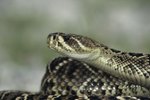
Seventeen species of snakes live in Michigan. Smaller species feed on worms and insects; larger ones eat birds and their eggs, as well as frogs, rodents and other reptiles. Since snakes are cold-blooded creatures who rely on the environment to regulate their body temperatures, they spend the harsh Michigan winters lying dormant underground. Snakes are found throughout the state in all habitats ranging from natural wooded areas to suburban backyards.
Eastern Massasauga Rattlesnakes
Eastern Massasauga rattlesnakes (Sistrurus catenatus catenatus) are the only venomous snakes living in Michigan. Although their bite is not deadly, anyone bitten by one of these snakes should seek prompt medical attention. These rattlesnakes are not common but may be found in swampy or marshy areas throughout the Lower Peninsula. No venomous snakes are native to the Upper Peninsula. Eastern Massasauga rattlesnakes can be most easily distinguished from harmless snakes by their eyes, which have catlike elliptical pupils rather than the round pupils of other snakes.
Garter and Ribbon Snakes
Aside from the rattlesnake, all other Michigan snakes are nonvenomous colubrid snakes. Garter and ribbon snakes are classified in the Thamnophis genus, one of two genera of colubrid snakes in the Natricinae subfamily. These medium-size snakes typically have stripes down their backs and grow to between 2 and 4 feet in length. Three species or subspecies of Thamnophis snakes live throughout both peninsulas: Butler's garter snake (Thamnophis butleri), the common garter snake (Thamnophis sirtalis) and the northern ribbon snake (Thamnophis sauritus septentrionalis). They are the most common snakes in the state.
Water Snakes
Water snakes in the Nerodia genus are the other genus in the Natricinae subfamily, and two species of water snakes live in Michigan. Northern water snakes (Nerodia sipedon) are the more common of the two species, living along the shores of lakes and streams. They grow to between 2 and 4 feet in length. Copper-bellied water snakes (Nerodia erythrogaster neglect), as their name suggests, have bright reddish-orange bellies that contrast with their dark brown or black backs. They grow to between 4 and 5 feet in length, making them one of the largest snake species in Michigan. The state lists them as endangered, and the species is considered threatened throughout the United States.
Other Colubrid Snakes
All other Michigan snake species are members of the Colubrinae subfamily of colubrid snakes. All species are nonvenomous; they kill their prey by constriction. Michigan species and subspecies include the blue racer (Coluber constrictor foxi), Kirtland's snake (Clonophis kirtlandii), the ring-necked snake (Diadophis punctatus edwardii), the queen snake (Regina septemnittata), the eastern hog-nosed snake (Heterodon platirhinos), the red-bellied snake (Storeria occipitomaculata occipitomaculata) and the smooth green snake (Liochlorophis vernalis). Colubrids in the Elaphe group are the largest snakes in Michigan, including the black rat snake (Elaphe obsoleta obsoleta) and two species of fox snake (Elaphe valpina and Elaphe gloydi). The remaining colubrid species, eastern milk snakes (Lampropeltis triangulum triangulum), are often misidentified as eastern Massasauga rattlesnake because of their rattling tails and blotchy scales. Like all colubrids, however, they are nonvenomous and harmless to humans.
References
- State of Michigan Department of Natural Resources: Michigan's Snakes
- State of Michigan Department of Natural Resources: Northern Water Snake
- State of Michigan Department of Natural Resources: Copper-Bellied Water Snake
- University of Pittsburgh: Snakes of North America
- Michigan State University Wildlife & Natural History Q-Line: FAQ -- Snakes
- University of Michigan Museum of Zoology: Animal Diversity Web: Colubridae -- Classification
- State of Michigan Department of Natural Resources: Eastern Garter Snake
- State of Michigan Department of Natural Resources: Black Rat Snake
Photo Credits
-
Jupiterimages/Photos.com/Getty Images
Writer Bio
Jennifer Mueller began writing and editing professionally in 1995, when she became sports editor of her university's newspaper while also writing a bi-monthly general interest column for an independent tourist publication. Mueller holds a Bachelor of Arts in political science from the University of North Carolina at Asheville and a Juris Doctor from Indiana University Maurer School of Law.




